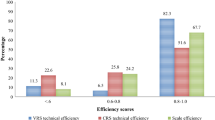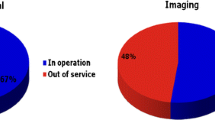Abstract
Background
Effective health care provision benefits from the support of measurement techniques. Contrary to the situation in industrialised countries efficiency analyses in the health care sector in Africa are a very recent phenomenon. Hardly any of the existing studies was conducted at the level of primary care.
Aim
The purpose of this study was twofold: (1) to evaluate the relative efficiency of health centres in rural Burkina Faso and (2) to investigate reasons for inefficient performance.
Methods
Data Envelopment Analysis (DEA) was applied. To account for the situation in that country, the output-oriented approach was used in connection with different returns to scale assumptions. To identify the spatial effect of the catchment area on efficiency the Tobit model was applied.
Results
According to constant returns to scale, 14 health centres were relatively efficient. The DEA projections suggest that the inefficient units were too big to be efficient. Tobit regression showed that the relatively efficient health centres are located close to villages in their catchment area.
Conclusions
For ethical reasons it is not appropriate to try to improve the efficiency of health centres by closing some of them. Their efficiency can be improved and lives can be saved if access to health centres is enhanced.
Similar content being viewed by others
References
Baltussen R, Yé Y, Haddad S, Sauerborn RS (2002) Perceived quality of care of primary health care services in Burkina Faso. Health Policy Plan 17:42–48
Banker RD, Charnes A, Cooper WW (1984) Some models for estimating technical and scale efficiencies in data envelopment analysis. Manage Sci 30:1078–1092
Banker RD, Charnes A, Cooper WW, Swarts J, Thomas D (1989) An introduction to data envelopment analysis with some of its models and their uses. In: Chan JL, Patton JM (eds) Research in governmental and nonprofit accounting. JAI Press, Greenwich, pp 125–163
Barnum DT, McNeil S, Hart J (2007) Comparing the efficiency of public transportation subunits using data envelopment analysis. J Public Transp 10:1–16
Butler TW, Johnson WW (1997) Efficiency evaluation of Michigan prisons using data envelopment analysis. Crim Justice Rev 22:1–15
Charnes A, Clark T, Cooper WW, Golany B (1985) A development study of data envelopment analysis in measuring the efficiency of maintenance units in U.S. Air Forces. Ann Oper Res 2:95–112
Charnes A, Cooper WW, Rhodes E (1978) Measuring efficiency of decision making units. Eur J Oper Res 2:429–444
Evans DB, Tandon A, Murray CJ, Lauer JA (2001) Comparative efficiency of national health systems: cross national econometric analysis. BMJ 323:307–310
Farrell MJ (1957) The measurement of productive efficiency. J R Stat Soc Ser A (General) 120:254–281
Gupta S, Verhoeven M (2001) The efficiency of government expenditure experiences from Africa. J Policy Model 23:433–467
Haddad S, Nougtara A, Fournier P (2006) Learning from health system reforms: lessons from Burkina Faso. Trop Med Int Health 11:1889–1897
Hoff A (2007) Second stage DEA: comparison of approaches for modelling the DEA score. Eur J Oper Res 181:425–435
Hollingsworth B, Dawson P, Maniadakis N (1999) Efficiency measurement of health care: a review of non-parametric methods and applications. Health Care Manag Sci 2:161–172
Kirigia JM, Emrouznejad A, Sambo LG, Munguti N, Liambila W (2004) Using data envelopment analysis to measure the technical efficiency of public health centers in Kenya. J Med Syst 28:155–166
Kirigia JM, Sambo LG, Scheel H (2001) Technical efficiency of public clinics in Kwazulu- Natal Province of South Africa. East Afr Med J 78(3 Suppl):S1–S13
Kouyaté B, Sie A, Yé M, De Allegri M, Müller O (2007) The great failure of malaria control in Africa: a district perspective from Burkina Faso. PLoS Med 4(6):e127. doi:10.1371/journal.pmed.0040127
Marschall P, Flessa S (2008) Expanding access to primary care without additional budgets? A case study from Burkina Faso. Eur J Health Econ. doi:10.1007/s10198–007–0095–9
Masiye F, Ndulo M, Roos P, Odegaard KA (2002) A comparative analysis of hospitals in Zambia: a pilot study on efficiency measurement and monitoring. In: Seshamani V, Mwikisa CN, Odegaard K (eds) Zambias Health Reforms Selected Papers 1995–2000. IHE, Lund, pp 473–481
Ministère de la Santé (2006) Annuaire statistique/ santé 2005. Ouagadougou
Mugisha F, Kouyate B, Dong H, Chepng’eno G, Sauerborn R (2004) The two faces of enhancing utilization of health-care services: determinants of patient initiation and retention in rural Burkina Faso. Bull World Health Organ 82:572–579
Ramanathan TV, Chandra KS, Thupeng WM (2003) A comparison of the technical efficiencies of health districts and hospitals in Botswana. Dev South Afr 20:307–320
Ray SC (1991) Resource-use efficiency in public schools: a study of Connecticut data. Management Science 37:1620–1628
Renner A, Kirigia JM, Zere EA (2005) Technical efficiency of peripheral health units in Pujehun district of Sierra Leone: a DEA application. BMC Health Serv Res 5:77. doi:10.1186/1472–6963–5–77
Sauerborn R (2005) Improving the quality of routine health services in the Nouna district through an iterative process of policy and research over the past 25 years. Ruprecht-Karls-Universität Heidelberg, Heidelberg
Traore C, Pale A (2005) Health inequalities in the rural district of Nouna, Bukrina Faso. Indepth health equality project. Indepth Working Paper Series No.3: Accra
Tavares G (2002) A bibliography of data envelopment analysis (1978–2001). Rutgers University, Rutcor Research Report, Piscataway
Würthwein R, Gbangou A, Sauerborn R, Schmidt C (2001) Measuring the local burden of disease. A study of years of life lost in sub-Saharan Africa. Int J Epidemiol 30:501–508
Ye M, Sié A, Millogo O (2005) Manuel de procedures du Centre Médical avec Antenne Chirurgical de Nouna. Nouna
Zere E, Mybeeli T, Shangula K, Mandlhate C, Mutirua K, Tjivambi B, Kapenambili W (2006) Technical efficiency of district hospitals: evidence from Namibia using data envelopment analysis. Cost Eff Resour Alloc 4:5. doi:10.1186/1478–7547–4–5
Acknowledgements
The authors would like to thank Ali Sié, Bocar Kouyate, Maurice Yé, Mamadou Mariko and Dimitri Poda for their support during the data collection.
Conflict of interest
The authors confirm that there are no relevant associations that might pose a conflict of interest.
Author information
Authors and Affiliations
Corresponding author
Rights and permissions
About this article
Cite this article
Marschall, P., Flessa, S. Assessing the efficiency of rural health centres in Burkina Faso: an application of Data Envelopment Analysis. J Public Health 17, 87–95 (2009). https://doi.org/10.1007/s10389-008-0225-6
Received:
Accepted:
Published:
Issue Date:
DOI: https://doi.org/10.1007/s10389-008-0225-6




